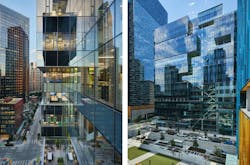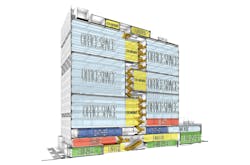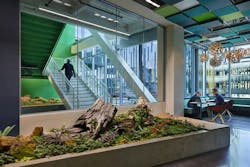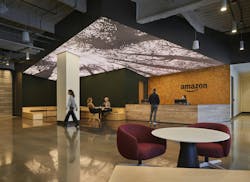Designing a new frontier in Seattle’s urban core
Occupying a 2,600-square-meter, half-block lot in Seattle’s central business district, the project brief was for a 40,000-sm office building, ground floor retail, and 1,200-sm childcare center. The project is the final tower in a five-block master plan for single, Seattle-based tech leader. Acknowledging that this final phase is the smallest and shortest tower of the multi-building campus, the design team developed an architectural response that simultaneously extends the design vocabulary and urban networks initiated by the existing structures while creating a massing and experiential solution unique to the block.
Inspired by the concept of an “Urban Treehouse,” the building's design seamlessly weaves nature and technology into its very core. The central open stair, reminiscent of the ascension to a treehouse, serves as a striking visual element, guiding occupants through the façade. Distinct floorplans revolve around this feature, creating moments of intrigue and discovery throughout the tower.
Urban Treehouse building design
The building’s structure is the armature, or “tree” through which the office program is woven and treehouse destinations discovered. Like lines on a map, steel and wood elements guide one’s journey through the building. Destinations are infused with character and identity, rich in color and texture, contrasting with the neutral surrounding context.
A neutral exterior palette allows the interior spaces to read through to the neighborhood campus; where color is introduced, it relates to distinctly legible circulation and program gestures. These include a low-rise extension of the podium, which houses a daycare; the building core, expressed in a gradient of variegated blue tiles; and the companion wall to the central stair, which employs graduated green tones diminishing in intensity as the stair ascends.
The stair is a social spine energizing every tower level, encouraging chance encounters, and expanding opportunities for interactions between individual occupants, teams, and guests. The office tower is also bracketed with collaborative social spaces at the building’s base and top, linked by the central stair that connects these and other additional shared program areas with focused workplace floors.
The tower’s structural solution is integral to the building form. Multi-story braced frames trace through the ascending tower, visible from the exterior as they follow the treehouse stair up the façade. These muscular braces are similarly revealed on the interior, where they express the armature of the “tree” through which the office program is woven. Distinctive ceilings and changes in floor material and level further define these interior experiences creating moments of prospect and refuge, compression and release, surprise, and delight. The result is a clear hierarchy of primary structure and secondary, place-making infill; memorably designed moments on one’s journey through the building.
The LEED V4 Gold certified project intertwines exterior and interior biophilic environments. Green roofs and landscaped terraces not only enhance the aesthetics but also play a crucial role in slowing down water runoff, mitigating the urban heat island effect. Interior landscaping is located adjacent to the open feature stair at various floor levels. Operable windows located on all office floors allow occupants to enliven their spaces with outside air, also benefiting the interior landscapes. The heating system utilizes high efficiency heat recovery chillers designed to re-use otherwise re-use otherwise wasted heat from neighboring data centers.
Sustainable thinking led to programmatic solutions as well to create a truly adaptable building. The offset core’s relationship to the feature stair successfully allows for changes to vertical and horizontal program distribution as occupant’s needs evolve. Individual floors may be subdivided, and the tower may be compartmentalized vertically to serve single or multiple tenants.
The urban treehouse offers an outpost from the forest of high-rise neighbors. Bridged together by a central staircase, the interior’s pathway for connectivity and togetherness represents the future of office buildings for the hybrid world. Frontier, while small in stature, is not lost in its context. It is in and of the forest of its high-rise neighbors, its own unique form in a neighborhood of taller siblings.
Project Details
Project Size: 540,000 sf
Lot Size: 38,880 sf
Photographer: Benjamin Benschneider
Client: Amazon
Designer: Graphite Design Group
Development Manager: The Seneca Group
General Contractor: Sellen Construction
Civil: Coughlin Porter Lundeen
Structural: Magnusson Klemencic Associates
Landscape: SiteWorkshop
Mechanical/Energy Design: WSP
Sustainability: Sellen Construction
Lighting: Oculus Light Studio
About Graphite Design Group
Graphite Design Group is a Seattle-based design firm recognized for crafting people-focused integrated environments that elegantly solve complex problems. Their diverse portfolio spans office, retail, hospitality, and mixed-use typologies, serving a broad clientele from boutique retail spaces to $400M development projects. With a team of experienced architects and designers, Graphite Design Group seamlessly blends creativity with functionality, consistently delivering bespoke designs that surpass expectations.




